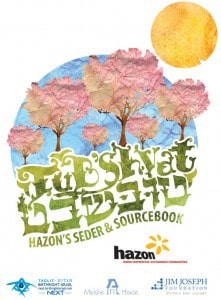 As the largest Jewish environmental organization in the country, Hazon hopes you will celebrate the holiday of Tu B’Shvat as a Jewish Earth Day and use our website resources to rekindle or deepen your feelings of gratitude for the bounty of the earth and take more steps towards preserving our world.
As the largest Jewish environmental organization in the country, Hazon hopes you will celebrate the holiday of Tu B’Shvat as a Jewish Earth Day and use our website resources to rekindle or deepen your feelings of gratitude for the bounty of the earth and take more steps towards preserving our world.
Tu B’Shvat begins sundown January 19th and we encourage you to hold a seder!
In the Middle Ages, Tu B’Shvat was celebrated with a feast of fruits in keeping with the Mishnaic description of the holiday as a “New Year.” In the 1600s, the mystic kabbalist Rabbi Isaac Luria of Tzfat and his disciples instituted a Tu B’Shvat seder in which the fruits and trees of Israel were given symbolic meaning. The main idea was that eating ten specific fruits and drinking four cups of wine in a specific order while reciting the appropriate blessings would bring human beings, and the world, closer to spiritual perfection. The mystical kabbalistic Tu B’Shvat seder has been revived and is now celebrated by many Jews, religious and secular. Special haggadot have been written for this purpose, including our own.
Download a beautiful Adult Haggadah, Family Haggadah, watch a G-dcast cartoon Video of Tu B’Shvat and learn Tu B’Shvat songs and blessings. Use the Leader’s Guide to prepare to lead your very own Tu B’Shvat Seder. Customize your Haggadah and save it for years to come.
Thanks to a generous grant from the Jim Joseph Foundation, we are able to provide these Tu B’Shvat resources to you. Already, we know that 34 Moishe Houses around the world and Taglit-Birthright Israel: NEXT participants in 7 cities will be using these materials. This haggadah will be used at Hazon and Congregation Romemu’s Seder at the JCC in Manhattan as well as at Urban Adamah’s and Wilderness Torah’s Seder in Berkeley. We encourage you to take advantage of them, too!
These resources are FREE to download.
Show the Content
Special thanks to Hazon’s wonderful staff, in particular Judith Belasco, Arielle Cohen, Leah Koenig, Sabrina Malach, Ben Murane, Nigel Savage, Anna Hanau, Deborah Newbrun, David Rendsburg, Jake Wilkenfeld-Mongillo, Rachel Loebl and Elisheva Urbas, for managing and developing Hazon’s Tu B’Shvat resources and materials; to our partners from Moishe House, led by Zev Bellin, for suggesting the berakhot chart and for much other helpful input; to Jeff Levy, creator of San Francisco’s Eco Tu B’Shvat Seder, and to our designers, Michael Cohen of BESHT Design and April Silver of Spring Thistle Design.
Hazon gratefully acknowledges support from the Jim Joseph Foundation, Taglit-Birthright Israel: NEXT, Bikkurim, the Dorot Foundation, FJC, Natan, the Chais family, the Kaminer family, UJA-Federation of New York, the Jewish Community Federation of San Francisco, the Peninsula, Marin and Sonoma Counties, more than 3000 donors and our amazing board and volunteers.
We are grateful to the Melton Research Center of the Jewish Theological Seminary of America and to Vicky Kelman, Joel Lurie Grishaver, and other educators
whose work in the 1970s and 1980s made ours possible. Many ideas in the Family Tu B’Shvat Haggadah echo their earlier work, especially the Ecology
Checklist at the end of the seder.
Thank you to Josh Miller and Renna Khuner-Haber for their contributions to the songs and music offerings.




No comments yet.